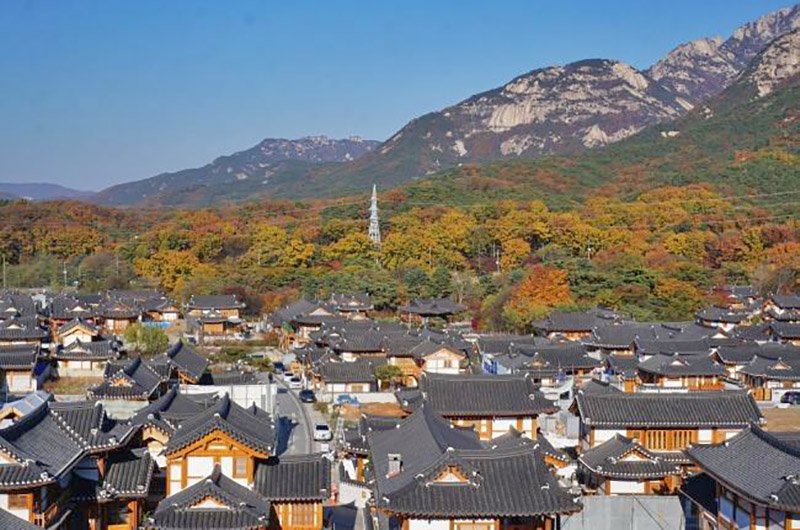A park at Mount. Bong in Gusan-dong area of Seoul’s Eunpyeong-gu District witnessed in July a rare scene that surprised visitors ― thousands of stick insects covering everywhere, from roads, trees, benches and exercise equipment to closed circuit television cameras here and there. Some were even found dangling on the bodies of trekkers too busy to notice. Some visitors freaked, while others found it fascinating, much to the creatures’ remarkable camouflage as a tree branch.
Eunpyeong office, together with the adjacent district office in Goyang city and Seoul’s forest management office, took to eradicating the insects twice ― in July and August. The authorities deployed drones to drop pesticides, an extreme measure never before used in Seoul for such a purpose.
The incident, experts say, did not have clear causes. It only led to hypotheses, one of which was that the insects hatched from eggs that survived last winter’s unusually warm climate.
Another generalization was that for some reasons the balance of the ecosystem in the park area collapsed, most likely because of human intervention.
“Stick insects are hard to find in Korea, much harder than grasshoppers,” Jung Boo-hee, a Korea University professor and the founder of Woori Entomological Institute in Yangpyeong County in Gyeonggi Province, told The Korea Times. Instead of being worried, the expert who has roamed forests and fields for nearly 30 years was elated to learn about the insects’ mass emergence in the city.
She was especially excited because Seoul was losing more natural habitats for insects with increasing apartment buildings and development projects. With the bugs disappearing, the city’s grassy zones were becoming “silent grass.”
“One stick insect lays hundreds of eggs. So it is possible that just a few of those eggs could have brought that mass infestation. It is also possible that the collapsed ecosystem swept away the insects’ natural predators like frogs or birds. In a normal natural balance, if there were thousands of insects appearing, their predators naturally come along as well.
“Those stick insects in Eunpyeong have been killed by their natural predators, all right ― humans, who keep interrupting the natural cycle of balance.” She doubted such an incident would happen again next year. She said it was rather random, as any species can mushroom in number “anywhere if conditions are right.”
Another random mass infestation of stick insects was witnessed several decades ago by Park Kyu-tek, an emeritus professor of Kangwon University and entomological fanatic in his late 70s. His published field research made him popular among global researchers wishing to identify unknown species of insects.
“I saw the insects when I was part of the environmental impact assessment group for Yongpyeong ski resort in Gangwon Province’s Pyeongchang County in 1975,” Park told The Korea Times. “They swarmed a verdant valley behind the site in number; so many I couldn’t even discern any green spot. The following year, I was curious if they were still there. I visited again and couldn’t see a single stick insect. And I haven’t seen another outbreak of the same kind.
“What had caused that outbreak? I still don’t know. This mass infestation is certainly happening more frequently than before. It is a sign that our ecosystem has sustained a penetration, like a hole. If the system was intact, we wouldn’t be able to notice any change.”
Entomological experts in Korea mentioned a “collapsed natural balance” as the most plausible reason behind random insect infestations in an out-of-proportional scale that have occurred in recent years in the country. This year has seen an unusually large number of gypsy moths and mosquitoes that carry Japanese encephalitis virus, like culex pipiens, nationwide. Chuncheon city in Gangwon Province in 2018 was engulfed by moths, while spotted lantern flies and citrus flatid planthoppers were also among species that have left a mass footprint.
Climate change is believed to be one of the strongest factors behind the broken natural balance.
“Many experts, including myself, believe that climate change and its global warming effect are linked to mass infestation of certain insects,” Nam Young-woo, a researcher from the National Institute of Forest Science, told The Korea Times.
“Insects are sensitive to ambient temperature. So, with a high temperature, bugs grow faster and their number grows faster as well. The mass infestation of stick insects and gypsy moths this year is because much of their eggs survived hibernation during the last winter, which was unusually warm and thus had a low fatality rate.”
Warm climate, together with enough humidity, can speed a larva’s cocooning process, slashing its duration from 30 days to half for all kinds of insects, according to Jung.
Jung had sensed in 2015 that climate conditions were seriously becoming unfavorable to bugs in Korea as days with high temperatures were increasing. The ever-shortening duration of the spring season also worried her.
“There are insects that fully grow and come out during a brief period during spring, about a week or two, when early spring flowers wither and late spring flowers begin to bloom, like longhorn beetles,” Jung said. “But those bugs couldn’t adapt to the climate that began to heat up in about May, which is earlier than usual summer. While flowers are naturally more adaptable to weather, insects, whose functions are more locked in with their daily life cycles than weather conditions, cannot keep up with such climate change.”
Korea does not yet have enough data to establish a firm causal relationship between climate change and the insect population, according to Jung. “While climate change certainly seems to influence the ecosystem, at least five to 10 years of monitoring is required to confirm the relationship,” she said.
Source: The Korea Times
